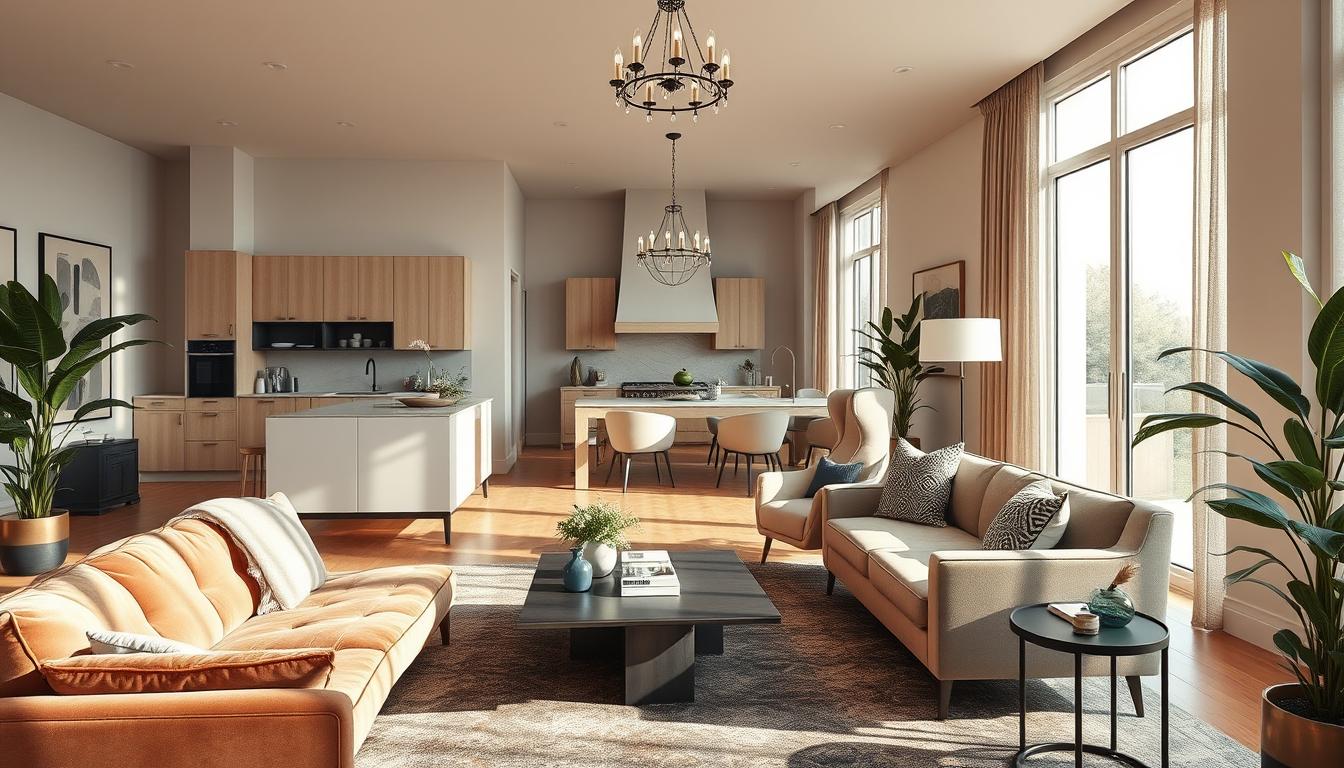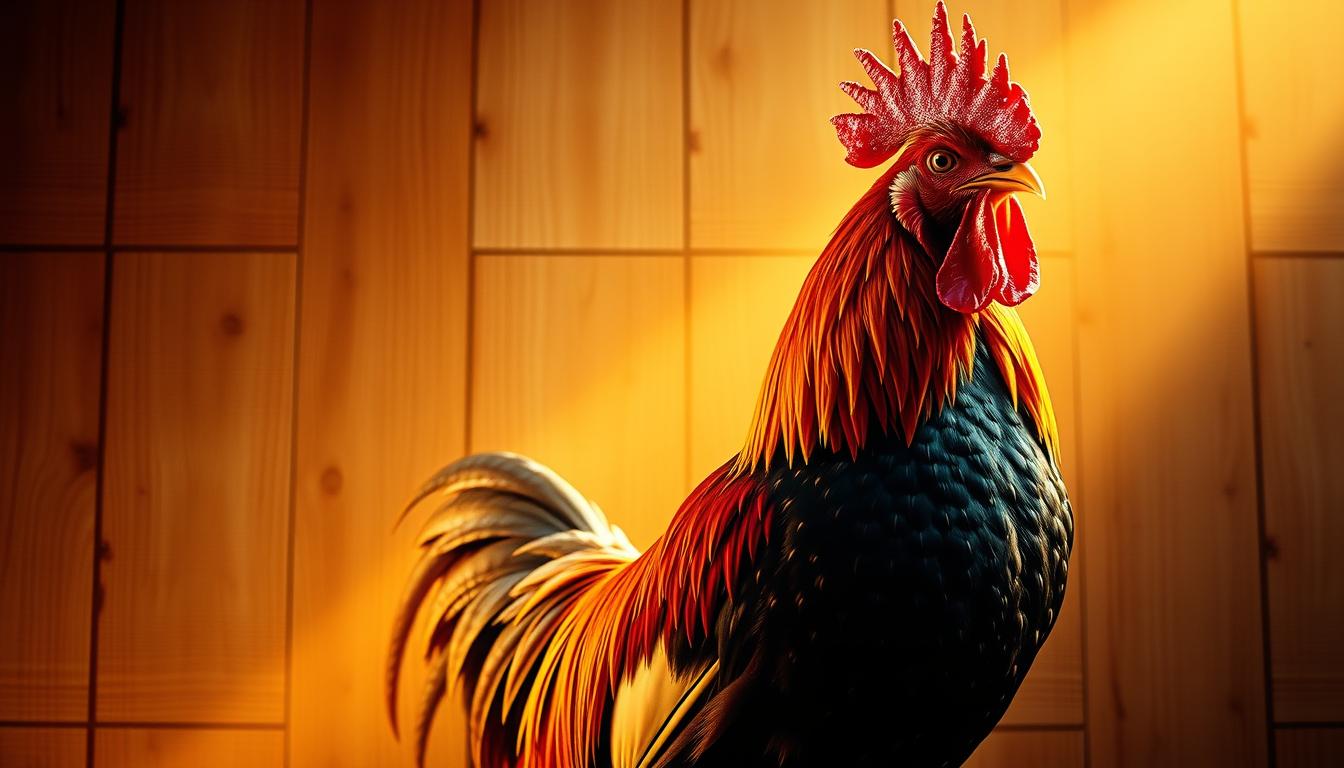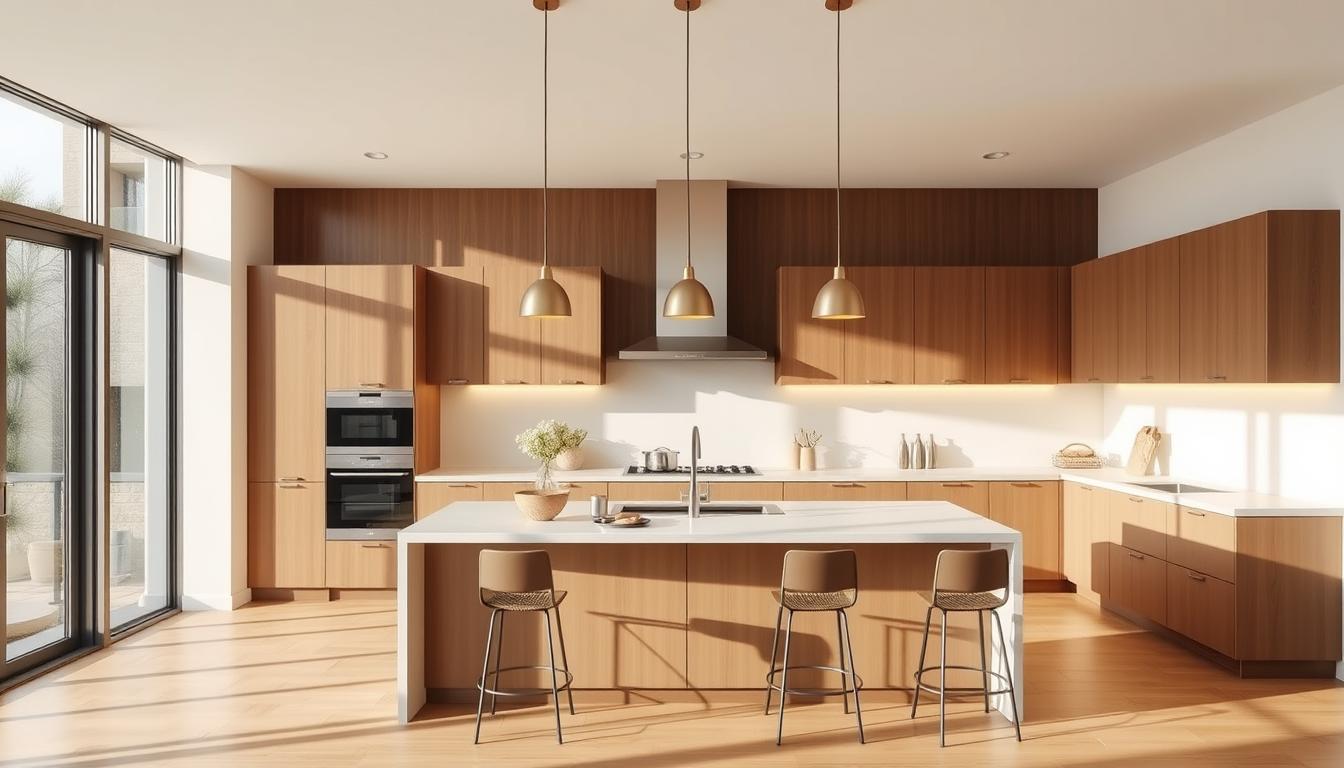Did you know that how we decorate our homes can affect our mood and work? With so many popular interior designs out there, picking the right one for your dream home can feel daunting.
Knowing the different styles is key to creating a space that shows who you are and meets your needs. In this guide, we’ll look at the most wanted home interior designs. We’ll help you choose the best style for your space.
We’ll dive into the world of interior design. We’ll talk about what each style is like, its history, and how to use it in your life.
Key Takeaways
- Understanding the impact of interior design on your lifestyle
- Exploring the most popular interior design styles
- Learning how to choose the perfect style for your space
- Discovering the characteristics of each design style
- Understanding how to incorporate your chosen style into your daily life
Understanding Home Interior Design Styles
Knowing the different home interior design styles is key to making your home welcoming and stylish. There are many styles, from modern to traditional. Each style adds its own special touches and feel to a home.
What is Home Interior Design?
Home interior design is about making a living space both useful and beautiful. It requires understanding design basics like color, texture, and space planning. Good design turns a house into a home that shows off who lives there.
Thanks to online design services, finding your perfect style is easier than ever. You can get help and advice from experts right at your fingertips.
Why Does Style Matter?
Your interior design style sets the mood of your home. It affects how your home looks and feels. The right style can make your home cozy, modern, elegant, or lively, based on what you like.
Also, the style you pick can boost your home’s resale value. A beautifully designed interior can attract more buyers if you ever want to sell.
Classic Design: Timeless Elegance
Classic design is known for its timeless beauty, inspired by 18th and 19th-century Europe. It brings a sense of elegance with its harmonious atmosphere. This is achieved through symmetrical layouts, rich colors, and classic shapes.
Key Characteristics
Classic design focuses on symmetry and balance. It arranges furniture and decor in symmetrical ways. This creates a stable and ordered feel. It also uses rich textures and materials like velvet and carved wood for depth.
Classic shapes, like arches and circles, add to its timeless charm. These shapes are used in furniture and decor to tie everything together.
Popular Color Palettes
Classic design loves warm, rich colors that feel luxurious. Earth tones like terracotta and deep blues are common. These colors are balanced with neutrals like cream and gray for harmony.
“The classic design style is all about creating a sense of timeless elegance and refinement, drawing on the best of traditional European design principles.”
Using these colors and characteristics, you can create a classic design. It will bring timeless elegance and sophistication to your home.
Modern Design: Sleek and Minimal
Modern design is all about being sleek and minimal. It’s not just about looks; it’s also about making your space useful.
Essential Features
Modern design has a few key things. It features clean lines, minimal décor, and focuses on functionality. You’ll also see neutral color palettes and natural materials like wood and stone.
“The modern home is a place where form and function come together to create a seamless living experience,” says a renowned interior designer. This quote shows what modern design is all about. Every part of it has a purpose.
- Open floor plans
- Large windows
- Minimal ornamentation
Furniture and Decor Choices
Furniture in modern design is simple and unadorned. It focuses on being comfy and useful. Decor choices often include geometric patterns and bold artwork. These add interest without making the space feel cluttered.
Some popular furniture pieces in modern design include:
- Sleek sofas with clean lines
- Minimalist coffee tables
- Geometric-shaped lighting fixtures
By using these elements, modern design makes a space that’s both stunning and practical.
Rustic Design: Cozy and Inviting
Rustic interior design celebrates natural materials and the charm of the past. It’s great for making your home warm and welcoming.
This style focuses on natural materials. Common materials used include reclaimed wood, stone, and brick. They add authenticity and warmth to any space.
Common Materials Used
Rustic homes often have exposed wooden beams, wooden floors, and stone fireplaces. These materials make a space cozy and interesting.
- Reclaimed wood for furniture and decor
- Stone or brick for fireplaces and walls
- Wooden beams for ceilings
Incorporating Nature
Bringing nature into your home is key in rustic design. Use natural textiles like woven baskets and jute rugs. Adding plants and flowers also helps.
For more inspiration, check out our guide on the top types of home interior design.
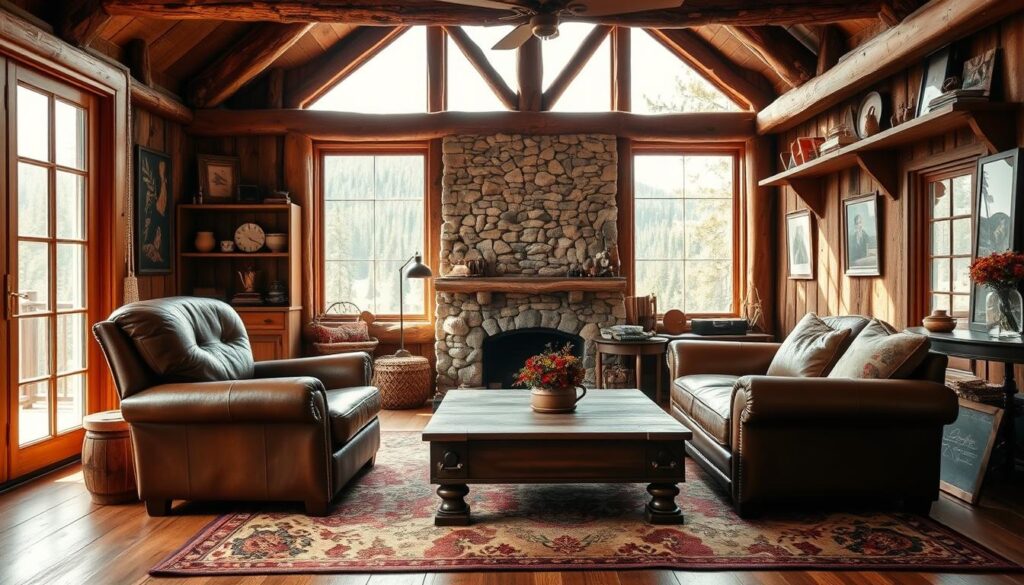
Industrial Design: Urban Chic
Industrial design brings a raw, edgy feel to homes. It’s perfect for those who love a modern, urban chic style. This look uses raw materials, keeps decor simple, and focuses on function.
Main Elements
Industrial design often includes exposed brick, metal beams, and reclaimed wood. These features give the style its rugged, urban vibe.
- Exposed Brick: Adds authenticity and history to a space.
- Metal Accents: Gives a sleek, industrial look.
- Reclaimed Wood: Brings warmth and character to industrial spaces.
Choosing the Right Lighting
Lighting is key in enhancing the urban chic of industrial design. The right lights highlight the style’s raw, industrial feel.
- Metal Lighting Fixtures: Match the industrial look.
- Exposed Bulbs: Add to the edgy, urban vibe.
- Industrial-Style Chandeliers: Can be a statement piece in a room.
Choosing the right lighting can make an industrial design look cohesive and stylish. It’s both chic and functional.
Bohemian Design: Eclectic and Free-Spirited
Bohemian design is all about being bold and unique. It’s a style that loves to mix things up, blending different cultures and art into one special place. This design is all about being free and showing off your own style.
Bold Patterns
One key part of bohemian design is its bold patterns. Vibrant textiles, intricate rugs, and eclectic wallpaper make a space pop. You can add these patterns with:
- Colorful tapestries
- Patterned throw pillows
- Unique, handmade ceramics
Mixing patterns creates a space that’s full of life and shows off your personality.
Personalization and Layers
Bohemian design is all about making a space your own. Adding family heirlooms, travel souvenirs, or personal artwork makes your space special. It tells your story.
Layering textures and elements is also key. You can do this by combining:
- Plush rugs with hardwood floors
- Velvet furniture with woven baskets
- Metallic accents with natural fibers
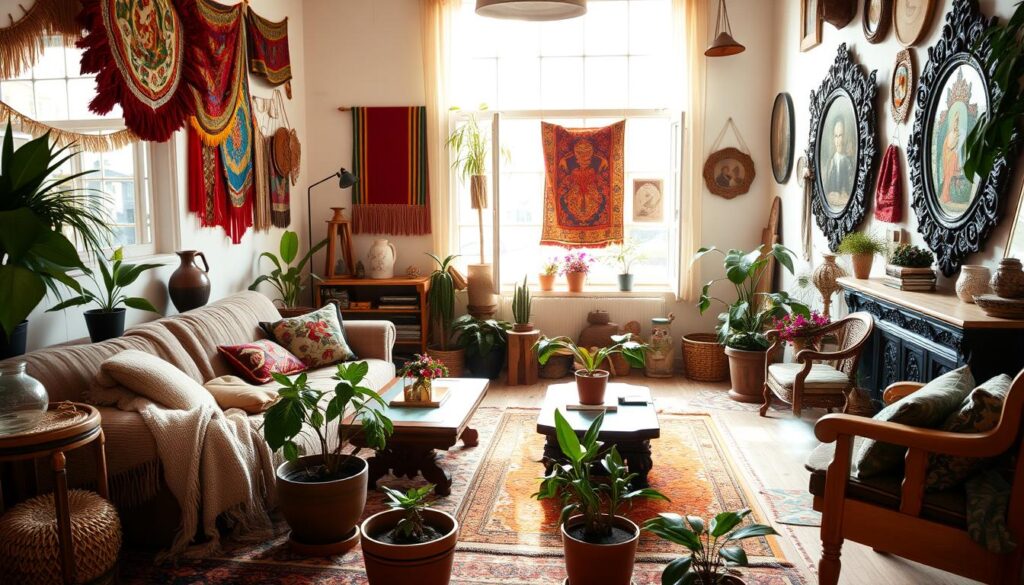
| Design Element | Bohemian Style | Traditional Style |
|---|---|---|
| Patterns | Mix of bold, vibrant patterns | Classic, subtle patterns |
| Textures | Layered, eclectic textures | Smooth, uniform textures |
| Personal Items | Prominent display of personal items | Minimal display of personal items |
Embracing bohemian design lets us create a space that’s not just beautiful but also deeply personal. It shows off our unique individuality.
Mid-Century Modern: Retro Vibes
Retro chic meets modern in mid-century modern design. It blends old charm with new practicality. Homes from this era are known for their open, airy feel. They reflect the architecture of their time, which loved connecting indoors with outdoors.
Iconic Styles
Mid-century modern design is all about its iconic looks. It uses shapes like circles and squares. The Eames lounge chair is a perfect example of this style’s focus on comfort and style.
The Eames lounge chair is more than just a chair. It’s a symbol of mid-century modern design. Its smooth lines and natural shapes make it a classic.
Furniture Selection
Choosing the right furniture is key to mid-century modern’s retro feel. Look for items with simple designs, little decoration, and a focus on being useful.
Important furniture includes sofas with slim legs, coffee tables with unique bases, and chairs with curved shapes. These pieces capture the mid-century modern look and enhance the space’s retro charm.
Contemporary Design: Current Trends
The world of contemporary interior design is always changing. It focuses on the present, blending different styles to make spaces feel modern and fresh.
Keeping Up with Change
Contemporary design is all about evolving. It uses the newest trends, tech, and materials to keep spaces feeling up-to-date. It doesn’t forget about classic principles, though. Instead, it mixes them with new elements for a unique look.
Key Elements of Contemporary Design:
- Open floor plans
- Minimal ornamentation
- An emphasis on functionality
- Incorporation of natural materials
Integrating Technology
Technology is a big part of contemporary design. It includes smart home systems and energy-saving appliances. This makes spaces more functional and modern.
Smart home technology is a key example. It lets people control lights, temperature, and security from anywhere. This adds convenience and style to homes.
To show what makes contemporary design special, let’s look at a table:
| Design Style | Key Features | Technological Integration |
|---|---|---|
| Contemporary | Open layouts, minimal decor, emphasis on functionality | High |
| Modern | Clean lines, simple forms, often monochromatic | Moderate |
| Traditional | Ornate details, rich colors, classic furnishings | Low to Moderate |
From the table, we see contemporary design is unique. It’s known for its tech use and focus on simplicity and function.
Scandinavian Design: Simple and Functional
Scandinavian design values simplicity, light, and natural materials. It comes from Nordic countries. It aims to make spaces beautiful and useful.
Emphasis on Light
Light is key in Scandinavian design. In Nordic winters, there’s less daylight. So, using light colors and few window treatments is important.
Natural Textiles
Natural textiles like wool, linen, and wood are important. They add warmth and texture. They make spaces cozy and comfortable.
For more on Scandinavian design, check out Architectural Digest’s guide. It offers a detailed look at this style.
| Key Elements | Description | Benefits |
|---|---|---|
| Light Colors | Use of white, beige, and light wood tones | Maximizes natural light, creates a sense of spaciousness |
| Natural Textiles | Incorporation of wool, linen, and wood | Adds warmth, texture, and comfort |
| Minimalism | Simple, uncluttered spaces | Enhances functionality, reduces visual clutter |
Traditional Design: Formal and Classic
Traditional interior design brings a timeless elegance to any space. It sticks to classic rules, making rooms both stylish and cozy.
Symmetry in Arrangement
Symmetry is key in traditional design. It means arranging furniture and decor in a balanced way. This creates a calm and beautiful look.
Experts say symmetry makes spaces feel good to look at. It’s not just about even spacing. It’s about making everything fit together perfectly.
Important Furnishings
Traditional homes often have dark timber and ornate furniture designs. These add to the room’s classic feel. Rich fabrics like velvet and silk also add luxury.
“The essence of traditional design lies in its ability to blend comfort with elegance, creating a warm and inviting atmosphere.” –
Antique furniture adds history and uniqueness to a room. When picking furniture, think about the look you want. Make sure each piece goes well with the others.
- Dark timber furniture for a classic look
- Ornate designs that add sophistication
- Richly patterned fabrics for depth and luxury
- Antique pieces for a touch of history
By using these elements and keeping things symmetrical, you can make a traditional space that feels both formal and charming.
Summary of Home Interior Design Styles
We’ve looked at many home interior design styles, each with its own special traits. Knowing these styles helps you make a space that shows off your style and tastes.
Key Takeaways
A quick reference table can help you compare the styles we’ve covered. Think about furniture, colors, and decor to pick a style that fits your home.
Choosing Your Style
To pick the right style for your home, think about what you like, how you live, and your home’s layout. This way, you’ll create a space that feels welcoming and truly yours.
Our Summary of Home Interior Design Styles gives you a full view of the styles we’ve talked about. It helps you make a smart choice when designing your home.

